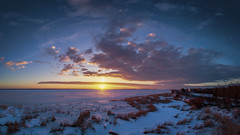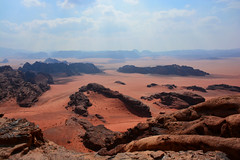Noma’s René Redzepi and the Link Between Nature and the Plate
René Redzepi and his Copenhagen restaurant Noma have been catapulted into fame since being voted the World’s Best Restaurant in last year’s San Pellegrino awards.
Known for using foraging techniques to find his produce, the chef is considered to be the founder of the Nordic Cuisine movement. The name of his restaurant is a conflation of the Danish words for Nordic (Nordisk) and food (mad). Opened in 2003, Noma is located in an old warehouse on Copenhagen’s docks, which have served as the casting off point for trade with the neighboring Danish territories of Greenland and the Faroe Islands for generations. These locations, along with Iceland, the ocean and Denmark itself, are now the source of most of the ingredients served at Noma.
Mr. Redzepi’s emphasis on wild and natural products appears to be a complete break with the molecular cuisine of Ferran Adrià’s El Bulli, which previously held the world’s best restaurant accolade for four years running. However, Mr Redzepi, who actually spent time working at El Bulli, said in a recent interview with The Wall Street Journal Europe that he sees no disconnect between molecular and Nordic cuisines.
WSJ: What cookbook has most influenced you?
Mr. Redzepi: I have read quite a few, starting with the classics like Carême and Escoffier, but if there was one book that inspired me, it was Thomas Keller’s “The French Laundry.” I came across it when I was working at El Bulli, but I had never been to America, especially not for the food, which in my mind was hamburgers, fast food or French chefs in New York cooking foreign cuisine. It was very individualistic and he found a way to be humorous about American food and pop culture. Suddenly I had this prejudice about America turned around. It was very inspirational, with quotes like “When in doubt, strain.” For me, this became “Listen to your doubts,” because if you have any, something must be wrong. So he caused me to change my plans about going to France and I went to the French Laundry in California instead.
WSJ: How did Noma progress in the early years?
Mr. Redzepi: We opened our doors in November 2003, and we were busy and I had good reviews. But for me it felt as if all I was doing was just cooking what I already knew from elsewhere. I felt I was cheating or stealing other people’s ideas. I just couldn’t see what would put us in the right direction to be groundbreaking and Nordic on a plate; there were no more directions to pursue. Take a carrot—in the first generation, you boil it in water; second, you glaze it in butter after boiling. But Ferran Adrià at El Bulli was already at generation two million in the way he cooked ingredients. So what is there to do that is new? It was so difficult.
WSJ: You’ve said before that the time you spent in Greenland during the winter of 2004 was a turning point in your career. Why was that?
Mr. Redzepi: I had gone there to shoot musk ox with one of our game suppliers, but we were trapped by a sudden snowstorm and stranded at Kangerlussuaq Airport, which used to be an old American base during the Cold War. I could not even charge my computer because they only had American plugs, so I was bored and stressed. But then at one point, I accepted it and so my mind wandered and I thought things through.
I re-evaluated what I was doing: Was it worth working 90 hours a week for a decent amount of praise? Can I devote myself to this for the rest of my life? It was at this point the mantra of time and place started to come through—how we need to show our guests what time of the year we are in and where in the world are we. And still today, it is exactly the same; it is kind of fun and a little theatrical, but it is still the same because that remains the core of our beliefs.
WSJ: How did you put that concept into practice?
Mr. Redzepi: I read cultural books, old recipe books with old-fashioned recipes to see what sort of things people ate. One of the most important discoveries was an old Swedish army survival book from the ’50s, which a soldier could use and survive in the wilds for a year without any problem. It also broke down the nutrients and what they did for your body. Once you are in nature and you find a product—it could be a berry or some type of plant or seaweed, it is natural you want the best of the best, the deepest color. And when you taste that in nature or even on a farm, that becomes your reference point for how that ingredient should taste. That is a very important lesson.
WSJ: Have foraging and wild food always been as important to you as they are today?
Mr. Redzepi: I have always been interested in hunting, and my partial upbringing in rural Macedonia meant we naturally picked berries and chestnuts in the mountains and fields while the grown-ups were working. This was how we played. So year by year, if you take it a step further, then you want to know what the root of a berry tastes like or the flowers, and your frame of reference becomes wider.
Before that [winter in Greenland], at Noma, we just telephoned a central supplier and ordered things without ever seeing where it came from or knowing how old it was, and the ingredients used were more or less the same all year round. I thought at that time we had the best of the best.
Then you start going into the wilderness, finding berries, plants, roots and seaweed and you realize that these things are important and year-by-year you suddenly notice how nature changes—what the weather does to it, what heat or rain do for products….Once you are in that framework, seeing how things change day by day sometimes, suddenly that becomes your entire inspiration so when you put food on the plate at the end of the day, it is an extension of nature. Suddenly you see yourself wanting a link from the natural environment of the given ingredients being as unbroken as possible to the plate.
WSJ: How important are local farmers in this process?
Mr. Redzepi: When we started talking to farmers every week about growing food and changing things, I was shocked at how low their self-esteem was. It is very easy for us to tell them they were doing a great job and we really appreciated their work, which made them happy and made them willing to experiment more. Some of them have changed things completely around and most of them are either organic or biodynamic. One of our carrot producers experiments with different crops and soils because he is so inspired. We have nearly 70 providers and foragers, and most of them have an annual invitation to eat here, as they really are part of our team.
And, of course, a lot of the people who work with us are making more money than ever because there is no middleman between them and us. We had thought about having our own farms, the way that Thomas Keller did at the French Laundry, but our relationship with our farmers is so close that we can get anything we want by working with them.
WSJ: How important are your “Saturday Sessions” at Noma?
Mr. Redzepi: They were one of the major developments in the creation of a team spirit. All of the staff participate, but its not so much about the food or ‘Thank you for sharing your good ideas with us and now we are going to steal it.’ No. The purpose was to give people a chance for interesting discussions, as we never have time to talk about food in a kitchen or, if so, not focused on a high level. If someone thinks of a new sauce, we can question why is it great or not.
WSJ: Your thoughts on food seem to be the opposite of the philosophy of molecular chefs. What do you think of their approach?
Mr. Redzepi: A lot of the techniques developed during the molecular phase have now been incorporated even into our style of cuisine because of their practicality. If housewives had precision equipment like a water bath, they would never overcook their meat. I think it can easily coexist with what we are doing.
WSJ: How often do you get customers who just don’t get it what you are trying to achieve?
Mr. Redzepi: We do get it a few times a week because it is just too different for them. For a lot of people, they have never tasted this style of ingredients before and they don’t have a reference point of what they eat. Some will like it but others think it is weird and prefer more conventional food. And we get strong reactions against the food sometimes—even the local critics used to call us “The Stinking Whale”!
WSJ: Do you have any plans to expand?
Mr. Redzepi: Every month someone offers to open [a restaurant] for me—not Las Vegas yet, but places such as Hong Kong or Thailand. It would be working against everything we are trying to achieve to take this to another place. I often say it would be possible if we spent a year and a half researching about their culture and the products, but it would be very expensive and time-consuming, and I can’t be in two places at the same time.
Perhaps countries that are not so gastronomically developed such as Poland should consider our approach. Good food that is focused locally and somehow makes sense on the plate can happen. We are doing it in Denmark, so it can happen anywhere.
By Bruce Palling for http://online.wsj.com/















